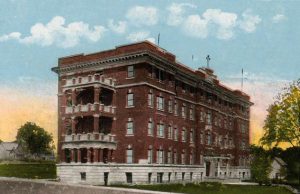isolation hospital
 Many years ago, anyone suffering from a communicable disease in Superior, Wisconsin, who wanted to save other family members from becoming ill could be treated at the Isolation Hospital. Superior’s twenty six room Isolation Hospital was located at 2222 East 10th Street, in Superior, Wisconsin. The hospital treated such diseases as smallpox, scarlet fever, diphtheria, and meningitis. Each of the diseases were treated in separate wards of the building, in an effort to isolate on illness from another. The hospital was managed by Mr and Mrs Peter Roe. The hospital always had a registered nurse on duty and patients could hire a private nurse as well, if needed. Mrs Roe cooked all the meals for the patients under the direction of their attending physicians. To help the patients pass the time while they were confined, “The Evening Telegram” and Superior citizens raised money for a radio. The hospital was under the supervision of Dr George Conklin. Because it was harder to cure diseases in days gone by, people might find themselves confined for some time, even the rest of their lives.
Many years ago, anyone suffering from a communicable disease in Superior, Wisconsin, who wanted to save other family members from becoming ill could be treated at the Isolation Hospital. Superior’s twenty six room Isolation Hospital was located at 2222 East 10th Street, in Superior, Wisconsin. The hospital treated such diseases as smallpox, scarlet fever, diphtheria, and meningitis. Each of the diseases were treated in separate wards of the building, in an effort to isolate on illness from another. The hospital was managed by Mr and Mrs Peter Roe. The hospital always had a registered nurse on duty and patients could hire a private nurse as well, if needed. Mrs Roe cooked all the meals for the patients under the direction of their attending physicians. To help the patients pass the time while they were confined, “The Evening Telegram” and Superior citizens raised money for a radio. The hospital was under the supervision of Dr George Conklin. Because it was harder to cure diseases in days gone by, people might find themselves confined for some time, even the rest of their lives.
Smallpox was probably the most widespread medical terror in our past. Smallpox outbreaks occurred in 1894 and 1872, and the state was swept by cholera in 1849. The same disease had decimated the troops at Fort Crawford in August 1833, taking down 23 soldiers and killing six. But the most notorious epidemic in our history was surely the Lake Superior smallpox outbreak of 1770, when the British deliberately introduced the disease among the Ojibwa Indians in revenge for the death of a fur trader. At least 300 people around modern Duluth-Superior were killed in this early act of bioterrorism. In August of 1895, smallpox had swept through the south side of Milwaukee where the traditions of recent Polish immigrants clashed with modern public health practices. The first patients were segregated at the Isolation Hospital outside the neighborhood, even though the residents preferred caring for their own sick in their own homes, as they had in the old country. When hospital patients began dying, the residents came to see it as a slaughterhouse where they would never send their loved ones. This only increased the spread of disease, of course, and soon thousands were affected. But when city health officials or ambulances attempted to remove patients to protect the uninfected, they were met by barricaded doors and armed uprisings.
Eventually Saint Mary’s Hospital replaced the Isolation Hospital. The new hospital was finished in 1911, but it  was the smallpox outbreak of May, 1915 that really put it to the test. The outbreak in Madison filled the hospitals and even took down the staff at Saint Mary’s, including the nurses and nuns. Smallpox was a terrible disease, for which there was no immunization in early years. Now with much hard work, and scientific research, it is considered a disease of the past. It also bears mentioning, that today, every time there is an outbreak of a contagious disease, doctors, nurses, staff, as well as friends and family wear protective gowns, gloves, and masks, in an effort to stop the spread of the disease. Medicine has come a long way since the days of the 1894 Smallpox epidemics. There are many ways to help people fight and win their battle against disease.
was the smallpox outbreak of May, 1915 that really put it to the test. The outbreak in Madison filled the hospitals and even took down the staff at Saint Mary’s, including the nurses and nuns. Smallpox was a terrible disease, for which there was no immunization in early years. Now with much hard work, and scientific research, it is considered a disease of the past. It also bears mentioning, that today, every time there is an outbreak of a contagious disease, doctors, nurses, staff, as well as friends and family wear protective gowns, gloves, and masks, in an effort to stop the spread of the disease. Medicine has come a long way since the days of the 1894 Smallpox epidemics. There are many ways to help people fight and win their battle against disease.

